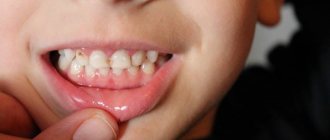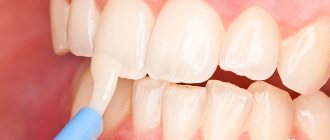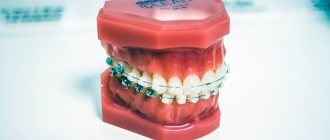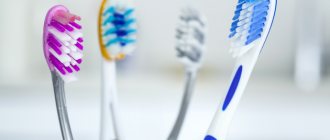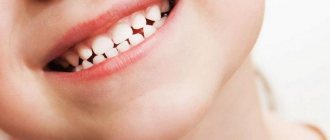Problem: Parents brought their 5-year-old child to Family Dental for professional teeth cleaning. The child has dark plaque on his teeth that cannot be removed with home remedies.
Solution: a brush with an abrasive paste partially removed the pigmented plaque, the remaining plaque was carefully removed with ultrasound, the teeth were polished and the tooth enamel was strengthened. As a result of professional teeth cleaning, the dark plaque on baby teeth is completely removed.
Causes of black plaque on children's teeth
There are many factors that cause black plaque on baby teeth. It is almost impossible to independently identify the cause, so you need to consult a doctor.
The most common causes of its occurrence are the following:
- Priestley's plaque in a child is the most common cause. This is due to special bacteria that produce a black pigment. It settles on the enamel, but goes away completely with age and almost never transfers to permanent teeth. This phenomenon is not dangerous to health and is considered only an aesthetic problem. Plaque can be removed at the dentist, but after a while it will still return. So you just need to wait until it goes away on its own.
- Caries. An equally common, but much more serious reason, since baby teeth are susceptible to the development of disease. They first turn yellow, black spots and spots appear, after which they turn black. The danger is that the disease will spread to permanent teeth if treatment is not started immediately.
- Dysbacteriosis. This disease can also cause problems with the digestive tract. Often occurs due to poor nutrition of the child, long-term use of antibiotics, and the presence of chronic liver or intestinal diseases.
- Excess iron. Quite often, young children are prescribed iron supplements, which often leads to the appearance of dark deposits on the teeth. At the same time, the color of the plaque can change from black to dark purple or brown.
In addition to the reasons listed, plaque can appear due to a lack of calcium, which certainly affects the teeth first. Sometimes it occurs due to impaired intestinal microflora or as a result of poor heredity - if the child’s parents had the same problem in childhood. In any case, to find out exactly the cause, it is necessary to consult a doctor in a timely manner for examination.
White spots on molars
This phenomenon occurs much less frequently than in the case of dairy rows. The process is often observed when installing a bracket system. The problem is provoked by an unbalanced, irregular diet, insufficient consumption of fresh vegetables and fruits, and milk. If this is really the root cause, it is enough to change the diet or reinstall the corrective orthodontic structure.
In adolescence, whitened areas often indicate the onset of caries development. If you contact a dental clinic in a timely manner, you will not need drilling of the affected tissue, filling or cleaning of canals after forced removal of the nerve.
Diagnosis and treatment methods of Priestley plaque
The appearance of black plaque can be the result of various diseases. In order to prevent them from starting and to prevent the development of complications, it is necessary to carry out a number of diagnostic measures. Even if a small spot appears on a tooth, you should visit a doctor and undergo laser diagnostics.
If it is caries, then at an early stage of development it is much easier to cure. In addition, the doctor may prescribe additional tests: blood and urine tests. Depending on the results obtained, appropriate treatment methods are selected:
- If problems with the gastrointestinal tract are identified, it is necessary to review the child’s nutritional system. In this case, a special diet is prescribed and some foods are excluded from the diet.
- Lack of calcium or excess iron can be easily treated by taking corrective medications and eating certain foods in greater or lesser quantities.
- When identifying caries at an early stage, dental procedures such as silver plating or fluoridation can help. The doctor treats the teeth with a special solution, which helps prevent further development of the disease and wait for healthy permanent teeth.
- Common Priestley plaque can be removed by professional cleaning by a doctor. But, unfortunately, this is not a guarantee that it will not appear again after a while.
If stains or plaque on the teeth cause pain or discomfort to the child, fillings are used to preserve the teeth and eliminate discomfort.
How to remove tartar from a child?
The problem can only be solved with the help of professional medical intervention. You will need to come to the appointment several times:
First appointment:
- the doctor conducts a diagnosis and discovers the problem;
- To make the child feel more comfortable, he applies topical anesthesia and painlessly removes dental plaque;
- The doctor provides training in home oral hygiene and selection of individual hygiene products.
Second reception, control:
- the dentist examines the oral cavity and evaluates the results of treatment;
- if necessary, repeat the procedure;
- The doctor once again repeats the recommendations given at the previous appointment.
Why do you need to remove Priestley plaque?
Not all children develop dark plaque on their teeth. This is due to the fact that the body reacts differently to changes in diet, environment and other factors.
In some cases, the spots may develop gradually, and in others they form abruptly, in just a few days. At the same time, age is not important: spots can appear already in the first months after teething, although on average they form at 2 years.
There are several reasons for removing Priestley plaque in children:
- Firstly, this is an aesthetic defect that attracts unnecessary attention to the baby’s mouth.
- Secondly, bad breath due to bacterial growth.
- Thirdly, under the guise of spots, the beginnings of carious lesions of the enamel may be hidden.
You can get professional services from a dentist and advice on this issue in Orel at our Center. Our specialists constantly encounter similar formations in children and know very well how to deal with it.
In just one session we will restore healthy enamel color using completely safe methods. At the same time, services for removing black plaque on a child’s teeth are available inexpensively in our clinic. We cooperate with each client on individual terms and adapt to the patient’s needs.
Also, if necessary, our doctors are ready to perform qualified treatment of childhood caries and other dental procedures. Our medical complex provides a wide range of services and can help with any oral ailment.
Plaque accompanied by dental caries
If caries has already appeared on plaque-laden teeth, parents will notice the following signs:
- the teeth become uneven, the surface, if you run your finger over it, becomes rough;
- enamel with caries loses its shine and becomes dull;
- upon examination it is clear: the darkening affected only the outer side; if there is a carious cavity, it is noticeable that the tooth is damaged from the inside.
It's hard to look at all of this on your own. Without experience and special knowledge, it is easy to make mistakes. Contact your dentist.
For clarity, we will present a table - it will be easier for you to understand what changes are happening to your teeth.
| Signs | Raid | Caries |
| Color | Whitish, yellow, brown, black | Most often noticeable by brown spots and stripes |
| Surface | Rovnaya | Rough, rough |
| Condition of adjacent teeth | Plaque usually covers several teeth - the entire upper or entire lower row | Caries most often develops on one tooth. Neighboring ones are either unchanged or covered with plaque |
| Child's feelings | None | Pain may occur when eating cold and hot food, or getting cold air into the cavities. |
How does the procedure for removing black plaque on teeth work?
Reliably and safely getting rid of dark spots on enamel is possible only with a professional dentist. Self-removal of black plaque in children using various folk remedies can lead to damage to the surface of the teeth.
Therefore, you should not self-medicate, but it is better to immediately use the services of specialists. At the Esculapius clinic we will find the root cause of the violation of the natural microflora of the mouth and eliminate the aesthetic defect from the enamel. At the same time, we use only effective methods that guarantee the highest quality results.
To treat Priestley's plaque, the Air Flow device is used, as well as ultrasound. During the procedure, a mixture of water, air and soda crystals is sprayed onto the teeth under pressure. The flow removes various types of deposits not only from the surface of the tooth, but also from the interdental spaces.
For children who do not really like brushing their teeth using the Air Flow method, soft plaque is removed with special brushes and pastes. After professional cleaning, the teeth are polished and become smooth, due to which less plaque settles on the enamel.
This procedure is available in our clinic at a reasonable cost. In addition, it is inexpensive to perform silvering of baby teeth - a preventive measure to strengthen the enamel and protect against caries, as well as other hygiene procedures. With us, your child's smile will be healthy and beautiful.
Let's sum it up
White spots on growing children's teeth do not always indicate the presence of a pathological process. Despite the positive statistics, you should not do anything on your own or self-medicate without consulting a doctor. You cannot delay a visit to the dental clinic, because it is much easier to get rid of the problem at the initial stage than in advanced cases associated with deep damage.
Sometimes light spots on the enamel indicate serious systemic pathologies, and a simple examination by a dentist will not be enough. Additional tests and advice from specialists will be needed.
By following preventive rules, you can prevent the appearance of light spots. It is important to teach your child to regularly care for his mouth and periodically show him to the dentist.
Possible complications after plaque formation in children
It is strictly not recommended to ignore the problem and wait until it goes away on its own (unless diagnostics have been carried out and the absence of diseases has been revealed).
Black plaque on a child’s teeth can be not only an aesthetic problem, but also a symptom of more serious and health-threatening diseases, which in their advanced form will require expensive and difficult treatment.
In addition, they can cause complications, which will also lead to unpleasant consequences:
- Inflammation and bleeding of the gums when eating or brushing teeth.
- The risk of developing various dental diseases increases, in particular caries, stomatitis and periodontal disease.
- Dense dark plaque quite often turns into tartar, so even with safe Priestley plaque, professional teeth cleaning is recommended at least once every six months.
- The appearance of bad breath, accompanied by toothache and a feeling of discomfort.
If the progression of plaque is caused by the lack of treatment for caries, the disease begins to fill deeper cavities, which leads to the development of pulpitis, periodontitis and other related diseases. As a result, baby teeth may need to be removed, which is highly undesirable.
Is it possible to remove plaque at home?
Everyone knows how reluctant children, especially young ones, are to visit the dentist's office. Therefore, parents, having discovered plaque on their children’s teeth, first of all ask themselves: is it possible to solve this problem at home? Even if brushing your teeth with an ordinary brush and toothpaste does not give the desired result, there are several methods for getting rid of plaque on your own.
Activated carbon
The simplest recipe involves the use of activated carbon. To do this, you need to grind one tablet to a powder. Then add a couple of drops of water to the resulting powder (you can add them using a pipette) to make a paste. Apply this paste to the child’s teeth using a toothbrush, and then brush the teeth with the same brush. After a few minutes, the activated carbon should be washed off completely.
It is common to use lemon to clean teeth from plaque. But it is only suitable for cases where the plaque is not very dense. You need to cut a small slice from the lemon and press it to your teeth. But you need to pay attention to the fact that not every child will like the taste of lemon, and in some cases, lemon can cause irritation of the mucous membranes.
Strawberry puree
This method of dealing with plaque will surely appeal to all children. You need to grind strawberries into puree and apply to the surface of your teeth. After a few minutes, the puree can be washed off.
However, you need to remember that the best way to remove plaque from your child’s teeth is to take him to a dentist, who will perform professional teeth cleaning.
Disease prevention
Preventive measures to prevent the development of dental diseases and the formation of plaque should be applied from the moment the baby first starts teething. The risk of unpleasant problems occurring can be significantly reduced by the following simple measures:
- Gentle oral care. Infants up to one year old can clean their gums with a cotton pad soaked in a decoction of chamomile, string, oak bark or sage. Special silicone attachments are also widely popular, which adults put on their fingers and thus clean the baby’s oral cavity. From the age of two, children must be taught to brush their teeth with a brush and toothpaste, and it is also advisable to rinse the mouth after each meal.
- Proper nutrition. This does not imply following any diets, but the child’s nutritional system should be designed in such a way as to limit his intake of sweets, sugar, confectionery and increase the consumption of healthy natural products. Sweets from the store are an excellent substitute for candied fruits, fruits and dried fruits.
- Timely abandonment of pacifiers and bottles. With prolonged use of a bottle or pacifier, an incorrect bite develops, dependence on accessories appears, and a black plaque forms, which in dentistry is called “bottle caries.” You should not delay in weaning your child off devices that he no longer needs.
- Maintaining the immune system. It is important to ensure that even in winter, the child has enough vitamins to maintain healthy teeth and the body as a whole.
By following these simple recommendations, you will ensure your child’s dental health and the beauty of a child’s smile.
return to list of articles
Is it possible to fix the problem at home?
Therapeutic tactics depend on the causes of the disease. If the problem is unsuitable water, it is enough to replace it with bottled water or install special filters in the house that remove fluoride from the liquid. The same goes for toothpastes and medications. It is important to avoid fluoride-containing foods.
When a child has grown teeth with white spots, you need to introduce foods rich in calcium and vitamins into his diet. For example, you should eat more vegetables, cheese, and drink milk.
Often the provoking factor is insufficient oral hygiene. Parents must teach their son or daughter how to properly perform hygiene procedures. Any available and effective teaching methods will do. Currently, there are many educational cartoons and programs that will help you learn all the intricacies of regular cleaning in a playful way.


